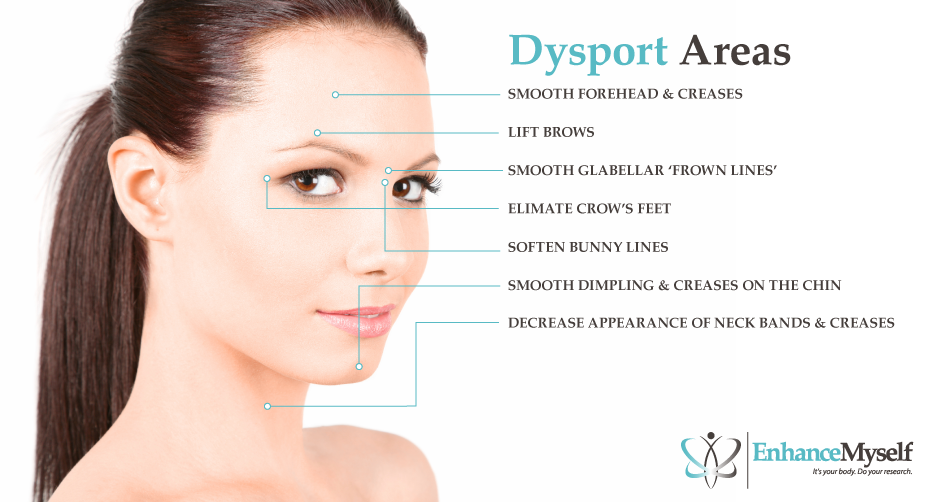Dysport Injections
-
Content written by Karen Vieira, PhD MSM | Reviewed by EnhanceMyself Medical Team | Last updated 6/22/2023
- Overview
Overview
What is Dysport?
Dysport is a brand name for a prescription injection that contains botulinum toxin type A. It is similar to Botox and is used for various medical and cosmetic purposes. It is a popular treatment for frown lines, laugh lines and other facial folds. Dysport works by temporarily paralyzing or relaxing the muscles that cause wrinkles or certain medical conditions.
Topics covered on this page
- Cost of Dysport injections
- Factors affecting the cost
- Are you a candidate?
- How Dysport works
- Common uses
- Treatment details
- Recovery time
- When to expect results
- How long will results last?
- Safety information
- Dysport vs. Botox
Cost of Dysport injections
The Dysport product usually costs around $4 to $8 per “unit,” which is the basic unit of measure of botulinum toxin products.
By contrast, Botox costs about $10 to $20 per unit. However, because Dysport is more dilute than Botox it takes about 2½-3 units of Dysport to get the same effect as 1 unit of Botox. For example, it takes approximately 50-60 units of Dysport to treat glabellar lines.
On average, the total cost of Dysport treatments will be around $400 to $800.
Factors affecting the cost of treatment
The cost of Dysport treatments can vary depending on several factors. The following are some of the top factors that can affect the overall cost:
- Your Provider: The experience of your Dysport injector can impact the overall cost. Highly skilled injectors with advanced training may charge more for their services.
- Location Matters: The geographic location of where your getting Dysport matters. In general, larger and more affluent areas tend to charge higher prices.
- Type of Clinic: The type of clinic can also impact pricing. Upscale clinics with additional amenities often charge higher fees.
- Number of Units: Dysport is usually priced per unit and the number of units needed depends on the area treated and the desired results. Areas with deeper wrinkles may require more units.
- Additional Treatments: Your treatment can be combined with other dermal fillers or laser treatments which could increase your overall cost.
To get an accurate price quote, schedule a consultation with an experienced Dysport injector near you. During the consultation, they can provide you with a breakdown of the costs involved based on your individual needs.
Is it right for you?
Dysport is FDA approved for the treatment of moderate to severe glabellar lines, which are the vertical lines located between your eyebrows.
Dysport is not meant for cosmetic use in people over 65.
Not all facial lines and wrinkles that come with age are caused by the muscles under the skin. Some are caused by loose skin, loss of fat tissue under the skin, gravity, and loss of the structures that support skin (such as the collagen and elastin matrix under the skin). Dysport is not effective for these kinds of aging changes.
You should not have a Dysport treatment if you are allergic to cow’s milk, or have a rash or infection at the injection site.
You should not have a Dysport treatment if you have a neuromuscular disease, or are pregnant or breastfeeding.
How it works
Some facial wrinkles are caused by the muscles under the skin exerting too much tension on the skin, thereby creating creases. When we are younger, our skin is supple and elastic enough to remain smooth and even despite the pull of these muscles. However, as we age and our skin loses its elasticity, the effects of these muscles produce creases and wrinkles. Dysport works by weakening or paralyzing these muscles, thereby releasing the wrinkle-causing tension on the skin.
Dysport uses
Dysport is injected to relax facial muscles, smoothing the wrinkles caused by these muscles. Dysport improves the appearance of moderate to severe glabellar lines (also known as “frown lines,” the wrinkles that occur between the eyebrows). Dysport is also used for medical purposes, such as treating:
- Muscle spasticity
- Cervical dystonia
Treatment details
Dysport injections are performed in a doctor’s office, and no anesthesia is required. However, some injectors may use ice to numb the area, or may offer a topical or local anesthetic.
After carefully measuring the amount of solution to be injected, the doctor then injects the Dysport into the targeted facial muscle using a thin needle. The entire treatment takes only about 10-30 minutes.
After the doctor has completed the injections you are free to leave the office immediately.
The best types of doctors for this treatment are board-certified dermatologists, plastic surgeons, or facial plastic surgeons.
Recovery time
Dysport injections are known as a “lunchtime procedure” because you can usually return to your daily activities immediately after a treatment. Ice can be applied to reduce any bruising or swelling. A few precautions are appropriate for the rest of the day after having a Dysport treatment:
- Do not lie down for four hours on treatment area
- Do not massage or apply heat to the area treated
- Avoid activities that cause flushing (such as sitting in a hot tub, exercising, or drinking alcohol)
When to expect results
The results of a Dysport treatment are not immediate. Results begin to appear 2-3 days after the injections, with maximum results taking up to two weeks.
How long will your results last?
The results usually last for up to 5 months. Depending on the area being treated, smoothing the wrinkle may require a series of 3 to 5 injections; the spacing and amount of solution injected into each treatment location depends on the desired results.
Safety information
Although Dysport injections are a non-invasive alternative to surgery, the procedure is not without risks. Dysport treatments may have side effects, which your healthcare professional should discuss with you during your consultation. The most common adverse reactions following glabellar injections with Dysport are:
- Drooping eyelids (ptosis)
- Injection site pain, redness, swelling
- Double vision
- Generalized muscle weakness
- Difficulty swallowing, speaking or breathing
- Urinary incontinence
- Allergic reaction (itching, hives, chest tightness, severe swelling)
Before Dysport treatment, speak to your doctor about all the potential risks and side effects.
Dysport vs Botox
Dysport uses the natural bacterial compound botulinum toxin A (abobotulinumtoxinA), the same active ingredient found in Botox.
Dysport holds some advantages over Botox. Since it is made with a smaller protein “load” than Botox, your body will not try as hard to attack it, so results should last a little longer. That said, this is still being debated and studied.
Also thanks to this smaller protein load, Dysport’s results appear slightly faster than Botox: 2-5 days, rather than 4-7. This makes it more effective if you have a date or special event on the horizon.
Once injected, Dysport “spreads out” somewhat more than Botox. This can be both a good thing and a bad thing. It’s very useful for treating larger areas, like the forehead or armpits. It means fewer injections, along with less swelling, bruising, and general discomfort. On the other hand, if administered by an inexperienced doctor, Dysport can spread into unwanted areas, causing negative side effects like blurry vision or drooping eyebrows. It also means that Dysport might not work as well for small areas, or thicker muscles, like between your eyebrows or around your mouth.
Dysport is also more diluted than Botox, which means you might require more treatments to acquire the same result. However, this means that Dysport is often cheaper per unit, which can potentially translate to a less expensive total cost, depending on your treatment.
In most cases, the deciding factor between Botox and Dysport is a matter of preference for either you, or the doctor administering your injection. There are several differences between the two, but mostly they’re remarkably similar.
Other Botulinum toxin A injectables include Xeomin and Jeuveau injections.
For more information about Dysport visit www.dysportusa.com.
EnhanceMyself.com relies on sources such as professional medical organizations, government agencies, academic institutions, and peer-reviewed scientific journals to write it’s articles. Learn more about how we ensure our content is accurate, in-depth, and unbiased by reading our editorial guidelines.
*Medical Disclaimer: This website does not provide medical advice. Read more.


